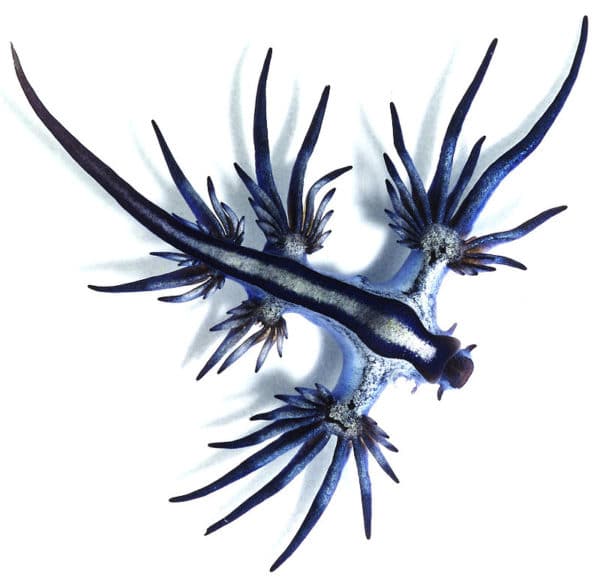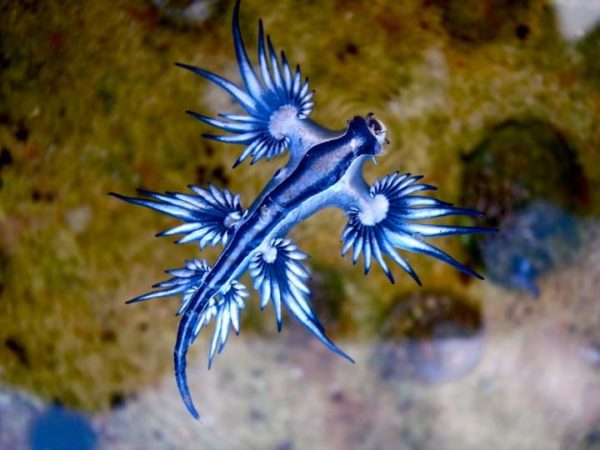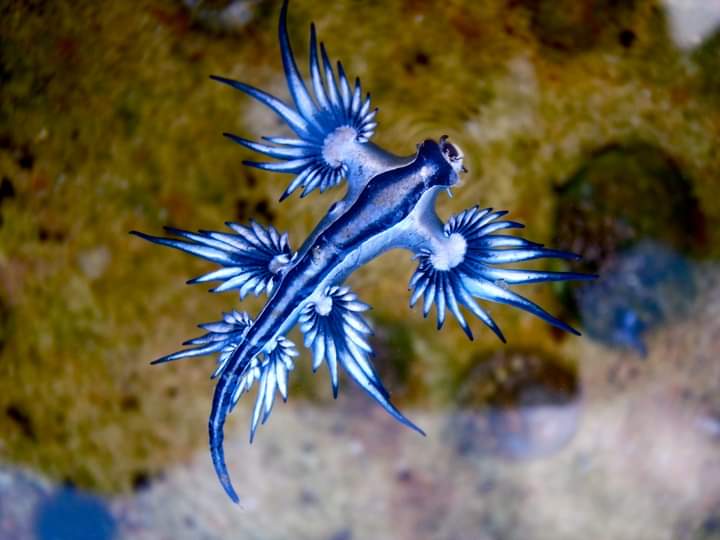Sea dragons – Sea slugs – have been sighted in the Alicante Mediterranean sea, for the first time in an historic discovery.
The blue sea dragon – Glaucus atlanticus – was seen on the coast of Alicante province, according to Torrevieja town hall biologist Juan Antonio Pujol.
“The spectacular marine blue sea dragon have never been viewed before on Spain’s Mediterranean coast,” said Pujol.
Glaucus atlanticus, common names include the blue sea dragon, sea swallow, blue angel, blue glaucus, dragon slug, blue dragon, blue sea slug, and blue ocean slug, is a species of small, blue sea slug, a pelagic (open-ocean) aeolid nudibranch, a shell-less gastropod mollusk in the family Glaucidae.
These sea slugs are pelagic; they float upside down by using the surface tension of the water to stay up, carried along by winds and ocean currents
The blue side of their bodies faces upwards, blending in with the blue of the water. The silver/grey side of the sea slugs faces downwards, blending in with the sunlight reflecting on the ocean’s surface when viewed facing upwards underwater.
They feed on other pelagic creatures, including the Portuguese man o’ war and other venomous siphonophores.
The sea slug stores stinging nematocysts from the siphonophores within its own tissues, as defence against predators. Humans handling the slug may receive a very painful and potentially dangerous sting!
Taxonomy
The species looks similar to, and is closely related to, G. marginatus, understood to be not one species, but a cryptic species complex of four separate species that live in the Indian and Pacific Oceans.
It shares the common name “blue dragon” with Pteraeolidia ianthina and G. marginatus.
At maturity, G. atlanticus can be up to 3 cm (1.2 in) in length; larger specimens have been found.
It can live up to a year under the right conditions. It is silvery grey on its dorsal side and dark and pale blue ventrally with dark blue stripes on its head.
It has a flat, tapering body and six appendages that branch out into rayed, finger-like cerata.
- atlanticus is usually found in tropical/subtropical areas, floating at the ocean’s surface due to the stored gulped air inside its stomach, usually feeding on cnidarians, which can be noisy due to air escaping its stomach as it feeds.
The radula of the species bears serrated teeth, which paired with a strong jaw and denticles, allows it to grasp and chip down parts of its prey.
With the aid of a gas-filled sac in its stomach, it floats at the surface. Due to the location of the gas sac, this species floats upside down. The upper surface is actually the foot – the underside in other slugs and snails.
This colouration is an example of countershading, which helps protect it from predators that might attack from below and from above.
The blue coloration is also thought to reflect harmful ultraviolet sunlight.
It has been recorded from the east and south coasts of South Africa, European waters, the east coast of Australia, and Mozambique.
Since the middle of the 19th century, records of this species have been reported on the Azores; also found in the Humboldt Current ecosystem in Peru in 2013, and off Andhra Pradesh in India in 2012.
Although the sea slugs live on the open ocean, they sometimes accidentally wash up onto the shore, so they may be found on beaches.
In April 2022, specimens were found in the Gulf of Mexico along the Texas coast.
The sea slugs can move toward prey or mates by using their cerata to make slow swimming movements and are known to prey on the dangerously venomous Portuguese man o’ war.
The species is able to feed on the Portuguese man o’ war – commonly seen in the Mediterranean sea across the Costa Blanca and Costa Calida- due to its immunity to the venomous nematocysts.
The slug consumes chunks of the organism and appears to select and store the most venomous nematocysts for its own use against future prey.
- atlanticus is able to swallow the venomous nematocysts from siphonophores such as the Portuguese man o’ war, and store them in the extremities of its finger-like cerata.
It can result in a painful sting, with symptoms similar to those caused by the Portuguese man o’ war, with symptoms that may appear including nausea, pain, vomiting, acute allergic contact dermatitis, erythema, urticarial papules, potential vesicle formation and postinflammatory hyperpigmentation.







